Your home should feel like you—not just a bunch of trendy stuff that doesn’t mean much. Showing off your personality while keeping things functional isn’t always easy, but you can totally do it. Honestly, the trick is finding that sweet spot where your style meets what you actually need every day.
Remember to repin your favorite images!
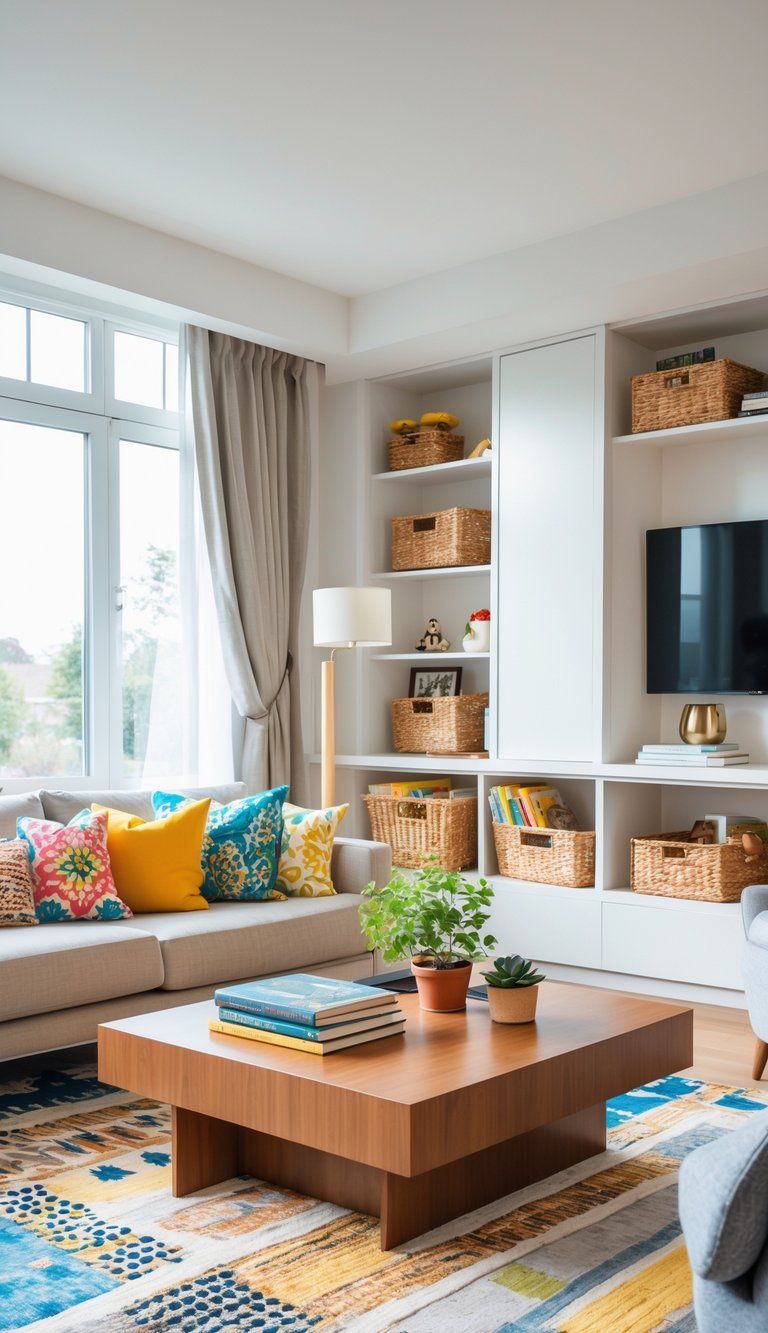
A lot of people wonder if they have to give up their unique taste just to make their home work well. Luckily, you really don’t have to pick one over the other.
With some smart planning and a few thoughtful choices, you can have both function and personality.
You can bring in meaningful artwork or pick out multi-purpose furniture to add character without letting clutter take over. Maybe you’re into vintage finds, or maybe you lean toward modern designs. Either way, your home can tell your story and still handle your everyday routines.
Understanding Your Personal Style and Home Functionality
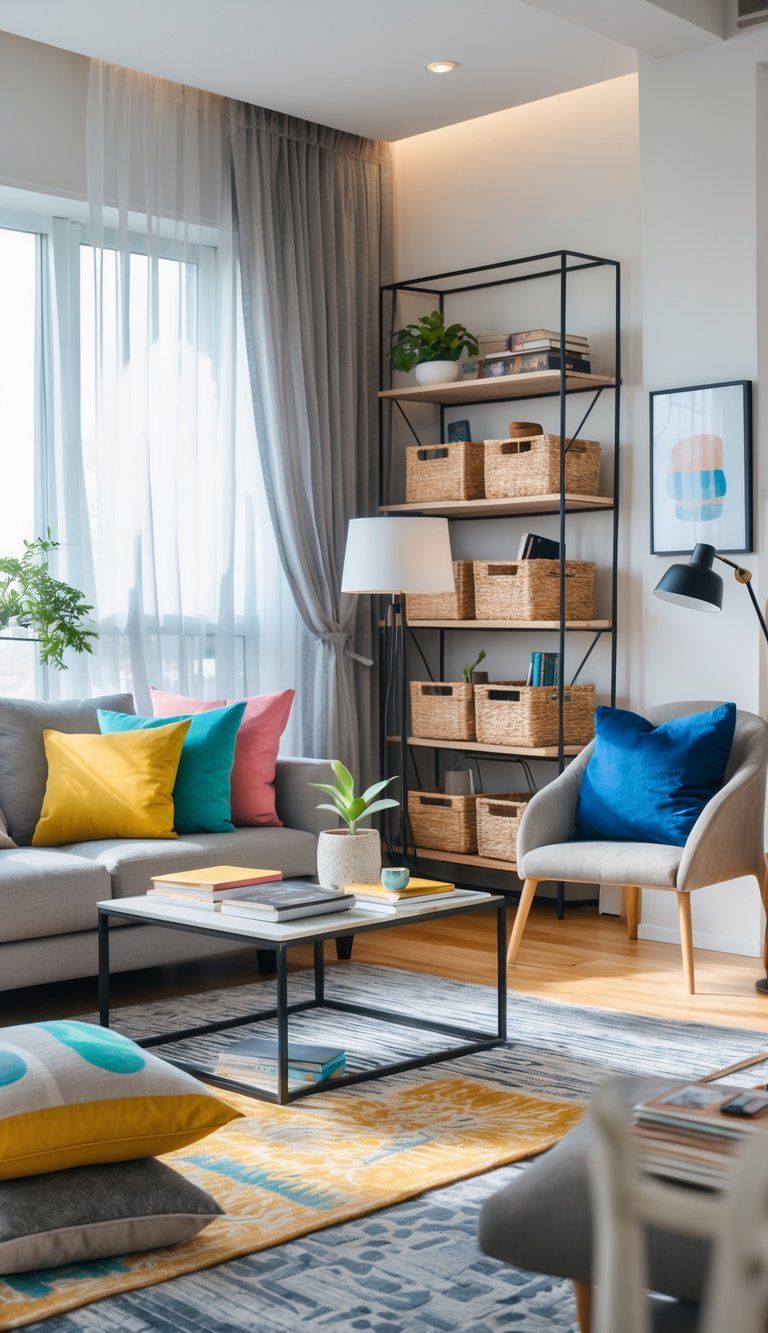
If you want your home to look like you and work for you, you’ve got to know what you love and what you actually need. This balance makes your space not just pretty, but liveable.
Identifying Your Personal Style
Personal style is just the visual stuff that feels right to you. Take a peek at your closet—do you go for classic looks or more of-the-moment pieces? That vibe usually shows up in your home too.
Flip through design magazines or start a Pinterest board. Save anything that grabs you. Are you into clean, modern lines, or do you want something cozier and more traditional?
Notice the colors, textures, and materials that make you feel at home. Maybe you can’t get enough of wood and natural fibers, or perhaps you love glass and metal.
Think about your life, too. Stuff like travel souvenirs, family heirlooms, or hobby collections can shape your style and make your space feel truly yours.
Assessing Functional Needs
Look at how you use your home, not just how you want it to look. Spend a week paying attention to your functional requirements.
Some questions to ask yourself:
- Who lives here?
- Do you work from home or host friends a lot?
- What actually happens in each room?
- Do you need special storage for hobbies or collections?
Write down what’s bugging you about your current setup. Maybe you wish your kitchen had more counter space, or your reading corner needs better lighting.
Think ahead, too. If you’re planning to age in place or start a family, your needs will change over time.
Each room has its own job. Your bedroom should help you relax, while your kitchen needs to make cooking easy.
Striking the Balance Between Style and Function
You’ll know you’ve nailed it when your home looks like you and works for you. Modern design is great at this—think “form follows function.”
Pick dual-purpose furniture like storage ottomans or tables that expand. These pieces look good and make life easier.
Try zoning your space by activity, not just by room name. Your living room could have a reading nook, a spot for chatting, and a media area.
A few ideas for style-function harmony:
- Wall shelves that show off your favorite things but also store stuff
- Cool lighting that brightens up work spots and adds flair
- Fabrics that resist stains but still feel comfy
Don’t be shy about customizing things. Even swapping out cabinet handles can blend function and style for cheap.
At the end of the day, the best homes have both purpose and personality. Your space should make your life easier and still make you smile when you walk in.
Creating a Mood Board for Your Space
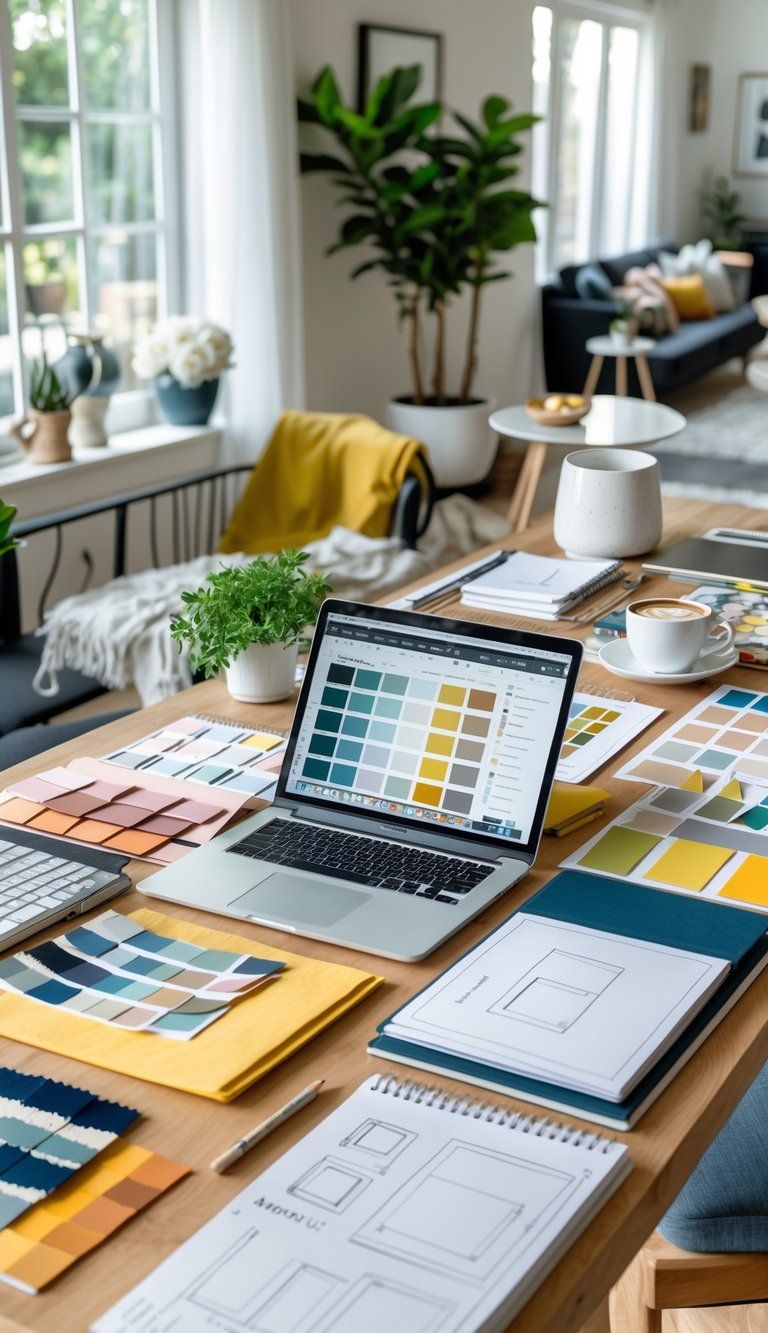
A mood board lets you see your design ideas before you buy or change anything. Pull together colors, textures, and pieces that show off your style and cover your practical needs.
Using Mood Boards to Visualize
Mood boards act like a visual cheat sheet for your project. They show how things will look together before you spend any money.
You can make a physical board with fabric samples, paint chips, and magazine clippings. Pin them to a corkboard or just lay them out on cardboard.
Digital mood boards are super flexible. Use Pinterest, Canva, or even PowerPoint to drag images around until something clicks. This works great if you’re sharing ideas with family or a designer.
The main thing is to capture the vibe you want. Look at your board and ask, “Does this feel like the room I want to hang out in?”
Selecting Inspirational Elements
Start with stuff that fits your style.
Colors: Pick 3-5 main colors for your color palette. Grab paint chips or fabric samples in those shades.
Textures: Try samples of wood, fabric, flooring, or wall coverings.
Functionality: Add pictures of storage hacks or furniture that actually solves a problem.
Personal stuff: Include photos of things you already own and love, or family pieces you want to show off.
Don’t rush it. Take your time and only add things that really feel right. That’s how you avoid a space that feels like it’s just chasing trends.
Translating Ideas Into Action
Once your mood board is set, use it to guide your shopping. Check back before you buy anything new to see if it fits your plan.
Make a simple spreadsheet with your main mood board items. Add columns for description, estimated price, where to buy, and how important it is.
Snap a photo of your mood board and bring it with you when you shop. It’ll help you stay on track.
Mood boards aren’t set in stone. If you find a new idea or run into a snag, just tweak your board as you go.
The best spaces show off your style and still work for real life. Make sure your mood board covers both.
Crafting a Functional Layout
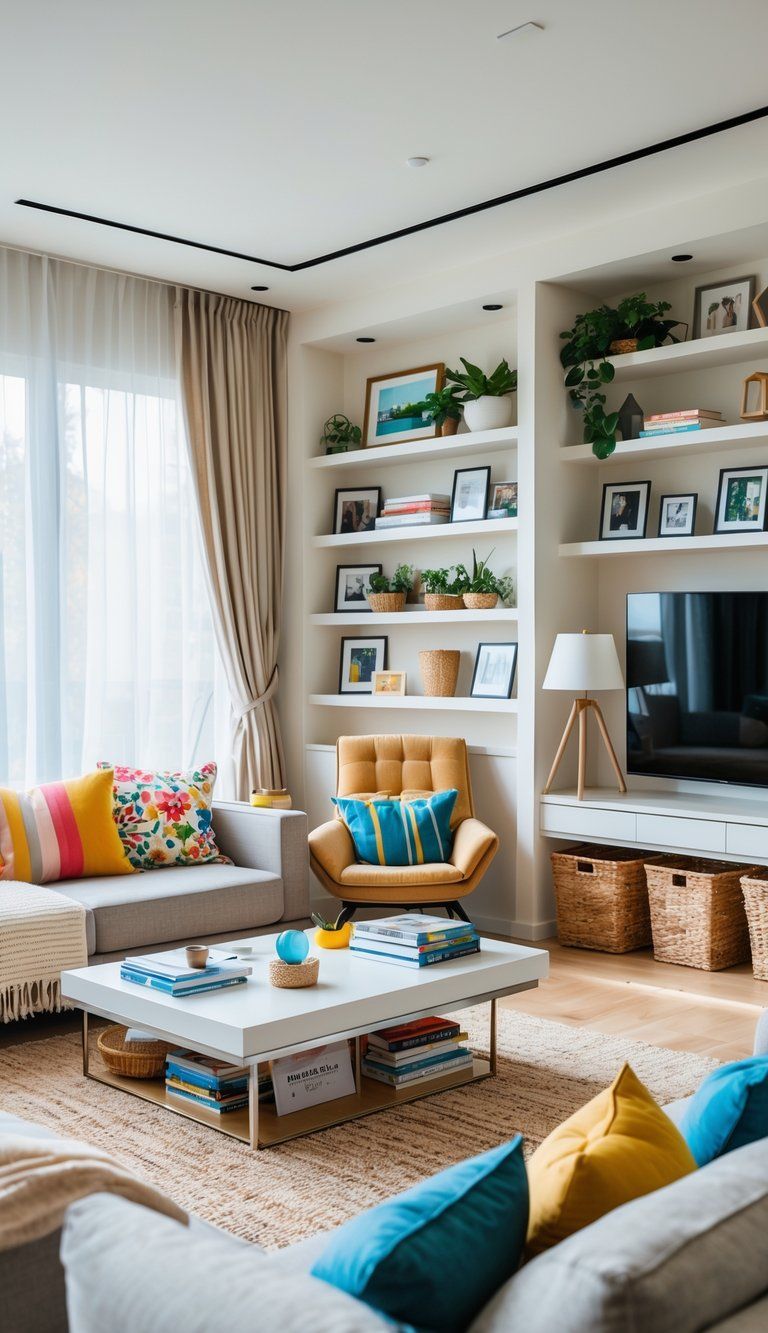
A good home layout is the backbone of both style and function. When you get the layout right, your space feels like it fits your life and your taste.
Optimizing Flow and Space
Start by thinking about how people move around. Arrange furniture so you have at least 30 inches of space between pieces. That way, you won’t keep bumping into stuff.
Connect rooms that go together, like putting the dining area near the kitchen for easier meals and cleanup.
Pick furniture that actually fits your space. Big pieces can crowd a small room, and tiny ones can get lost in a big space. Always measure before you buy.
Go for multi-use pieces when you can:
- Coffee tables with storage
- Ottomans that double as seats and storage
- Expandable dining tables
- Murphy beds or sleeper sofas for guests
Designing for Daily Routines
Lay out your rooms to match how you actually live. Think through a typical day and arrange things to make life smoother.
Set up zones for different activities. Maybe you want a reading spot by the window, a homework nook for the kids, or a coffee station in the kitchen.
Put storage where you need it most. Keep kitchen tools near the stove, cleaning stuff where you use it, and hang keys by the door.
Think about how everyone moves through the house. If mornings are crowded in the bathroom, maybe add double sinks or a separate toilet room.
Plan for tech, too. Make space for cables, charging stations, and solid Wi-Fi in every room.
Prioritizing Comfort
Don’t trade comfort for looks. You can have both if you pick the right furniture.
Try out seating before you buy. Something that looks amazing online might actually be uncomfortable at home. Make sure the seat depth, height, and support feel good to you.
Set up conversation spots where people can talk without having to twist or shout.
Think about temperature and lighting. Keep furniture away from drafty windows in winter, and make sure there’s enough light for whatever you’re doing.
Use rugs, curtains, and cushions to help with sound if your room feels echoey. If you can, keep noisy appliances away from quiet areas.
Space Planning for Maintenance and Longevity
A layout that works makes cleaning and upkeep way easier. Leave enough space to vacuum or sweep around furniture.
Pick the right flooring for each spot. Busy areas need tough materials, while bedrooms can be softer and cozier.
Plan for storage so clutter doesn’t take over. Built-ins make the most of vertical space. Try things like:
- Closets with adjustable shelves
- Storage under the stairs
- Wall cabinets in tight rooms
Think ahead about accessibility. Wider doors, fewer steps, and easy-to-use bathrooms help if you want to stay in your home as you age or have guests with mobility needs.
Leave some wiggle room for your style to change. A good layout lets you update your look without major hassle. Invest in quality basics and swap out the little stuff as your taste evolves.
Selecting Color Palettes to Reflect Personality

Colors can really show who you are and set the mood for your home. Your choices lay the groundwork for the vibe you want, and they can highlight your personality while still making your space practical.
Choosing a Signature Color Palette
Start with colors that make you feel good. Look at your clothes, favorite art, or places you love for inspiration. Usually, your gut knows what feels right.
If you love bold colors like reds and oranges, you probably want a lively, social space—great for living rooms. Blues and greens chill things out, so they’re perfect for bedrooms or home offices.
Think about how colors feel in different rooms. Yellow can make kitchens happy, and lavender can help you relax in the bathroom.
Use the 60-30-10 rule to keep things balanced:
- 60% main color (walls, big furniture)
- 30% secondary color (smaller furniture, rugs)
- 10% accent color (art, pillows, little details)
Incorporating Accent Colors and Neutral Tones
Neutrals give you flexibility and keep things from feeling too busy. They let your favorite pieces stand out.
A few classic neutrals and their vibes:
- Warm beiges and taupes: cozy and welcoming
- Cool grays: sleek and modern
- Crisp whites: fresh and open
Accent colors let you get creative without a big commitment. Try pillows, vases, or art in bolder shades to add punch without overwhelming the room.
In small spaces, lighter colors can make things feel bigger, and you can add depth with darker accents. In open or larger rooms, deeper shades help create a sense of coziness and can break up the space.
Coordinating Colors with Home Décor
Tie your color palette to the furniture and architectural features you already have. Wood tones, flooring, and built-in elements should work with your color choices—not fight against them.
A color wheel comes in handy when you want to find combinations that feel right:
- Complementary colors (they sit across from each other): bring energetic contrast
- Analogous colors (side by side): give a more subtle, unified vibe
- Monochromatic schemes: use different shades of one color for a sophisticated touch
Always try out paint samples before making a final decision. Put swatches on a few walls and check them throughout the day—lighting can totally change how a color looks.
Think about keeping things flexible for the seasons. If you stick with neutral backgrounds, you can swap out accent pieces as your mood or the weather changes. It’s a simple way to keep things feeling new without doing a full makeover.
Layering Textures and Materials
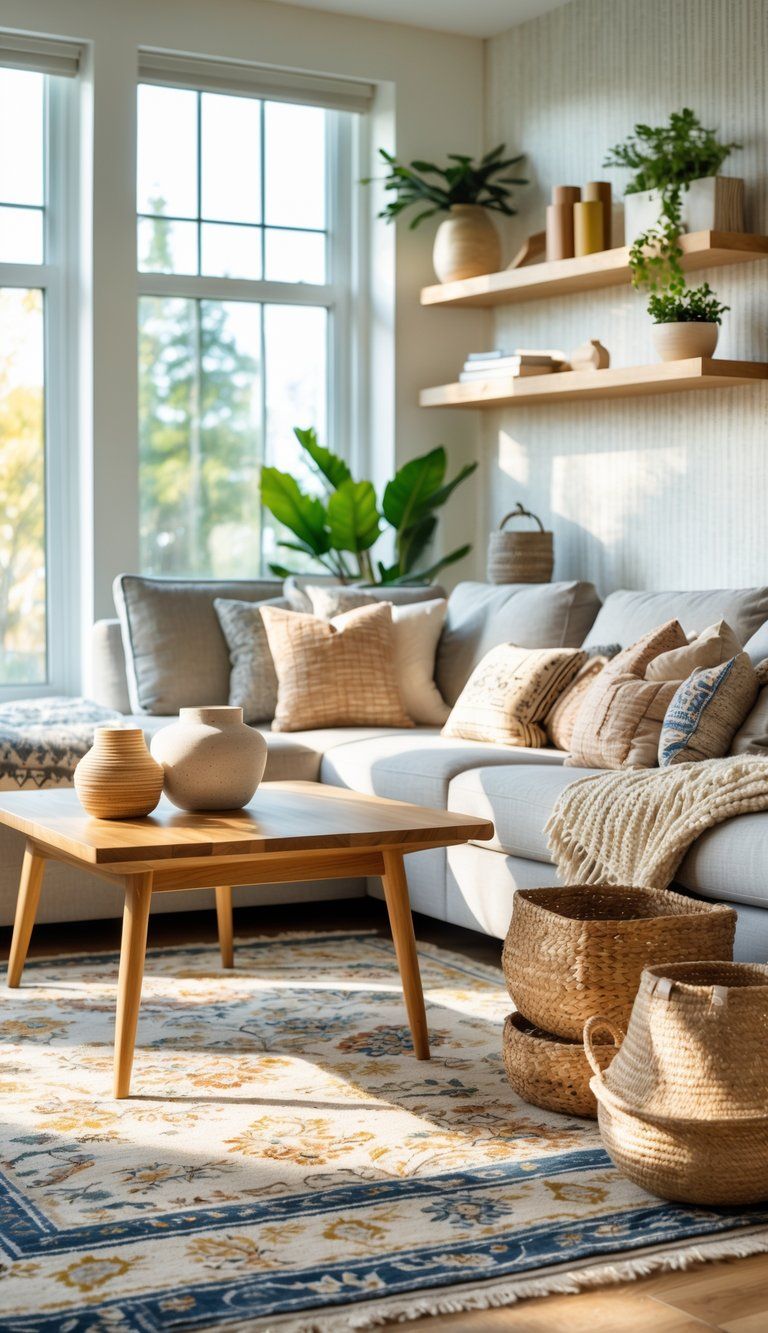
Mixing up textures and materials brings life and personality into your home. This approach adds layers and makes your space more inviting.
Mixing Textures for Depth
Start with just two or three main textures in a room. You want balance, not chaos. Pair something sleek—like glass or polished metal—with rougher pieces such as natural wood or stone.
Maybe you place a leather sofa next to a brick wall, or toss a chunky knit throw over a velvet chair. Those little moments make a room feel thoughtful and interesting.
If space is tight, bring in texture through accessories. Try textured picture frames, a ceramic vase, or a woven basket. They add charm without crowding things.
Selecting Textiles and Rugs
Textiles are the easiest way to change up texture and show a bit of your personality. Mix cotton, linen, wool, and silk for variety and comfort.
Layering Ideas:
- Living Room: Use a low-pile rug, then add textured throw pillows in matching or contrasting colors.
- Bedroom: Layer a quilted comforter over crisp sheets, then toss a faux fur or chenille throw at the end of the bed.
- Kitchen: Woven placemats, cotton towels, and fabric chair cushions can all add interest.
Try layering rugs if you want more warmth and depth. Put a smaller patterned rug on top of a big natural fiber one to define spaces and boost style.
Integrating Flooring Choices
Your floors set the stage for a room’s texture story. Hardwood brings warmth and works with most styles.
If you want more character, reclaimed wood flooring adds personality and a bit of history. For something durable, luxury vinyl planks can look like wood or stone but hold up better in busy areas.
Area rugs help define spaces and add softness. Choose wool for tough, high-traffic rooms, cotton for kitchens, and plush options for cozy bedrooms.
Transitions between different flooring types matter too. Add details like a decorative tile border or a metal strip for a little extra texture.
Personal Touches With Artwork and Wall Art
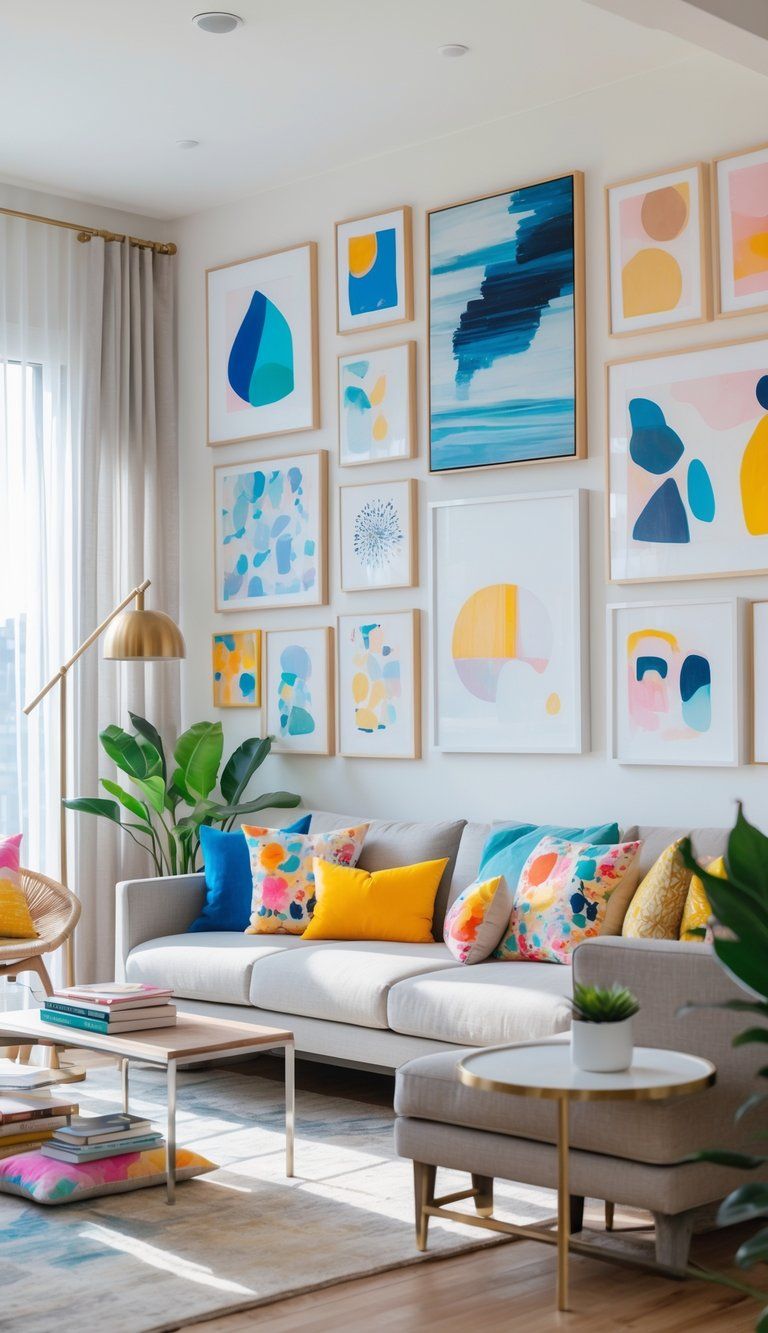
Artwork brings your walls to life and lets your personality shine. The right pieces tell your story and still fit the flow of your home.
Creating a Gallery Wall
Gallery walls are a fun way to show off what matters to you. Pick a theme or color palette that matches your style—maybe family photos, nature prints, or abstract art in similar shades.
Lay everything out on the floor before you start hanging. It’s a lot easier to move things around there than patch holes later.
Try these layouts:
- Grid pattern: neat and structured
- Salon style: more playful and eclectic
- Horizontal line: simple and tidy
Go with matching frames for a pulled-together look, or mix up frame styles for more personality. Leave a couple of inches between pieces so things don’t feel crowded.
Selecting a Statement Painting
Sometimes one big piece of art says more than a bunch of small ones. When you pick a statement piece, think about the room’s colors and what you want the space to feel like.
In the living room, pick art that sparks conversation. For bedrooms, look for calming images that help you relax.
A few quick tips:
- Measure your wall before you shop.
- Try to fill about two-thirds of the space.
- Hang art at eye level—about 57-60 inches from the floor to the center.
Don’t rush. Choose something you love, not just what’s trendy. You’ll be living with it for a while.
Displaying Personal Artwork
Show off what makes your home yours. Kids’ art, your own creations, or family keepsakes add real character.
Frame your kids’ work in simple frames to make it feel special. Swap out pieces now and then to keep things fresh and celebrate new creations.
Try a wall set up for rotating displays:
- Use magnetic paint and colorful magnets
- Hang a cable system for easy swapping
- Add floating shelves to lean and rearrange art
Digital photo frames are handy if you’re short on wall space. They can cycle through travel pics or family memories and don’t take up much room.
Enhancing Ambiance With Lighting Choices
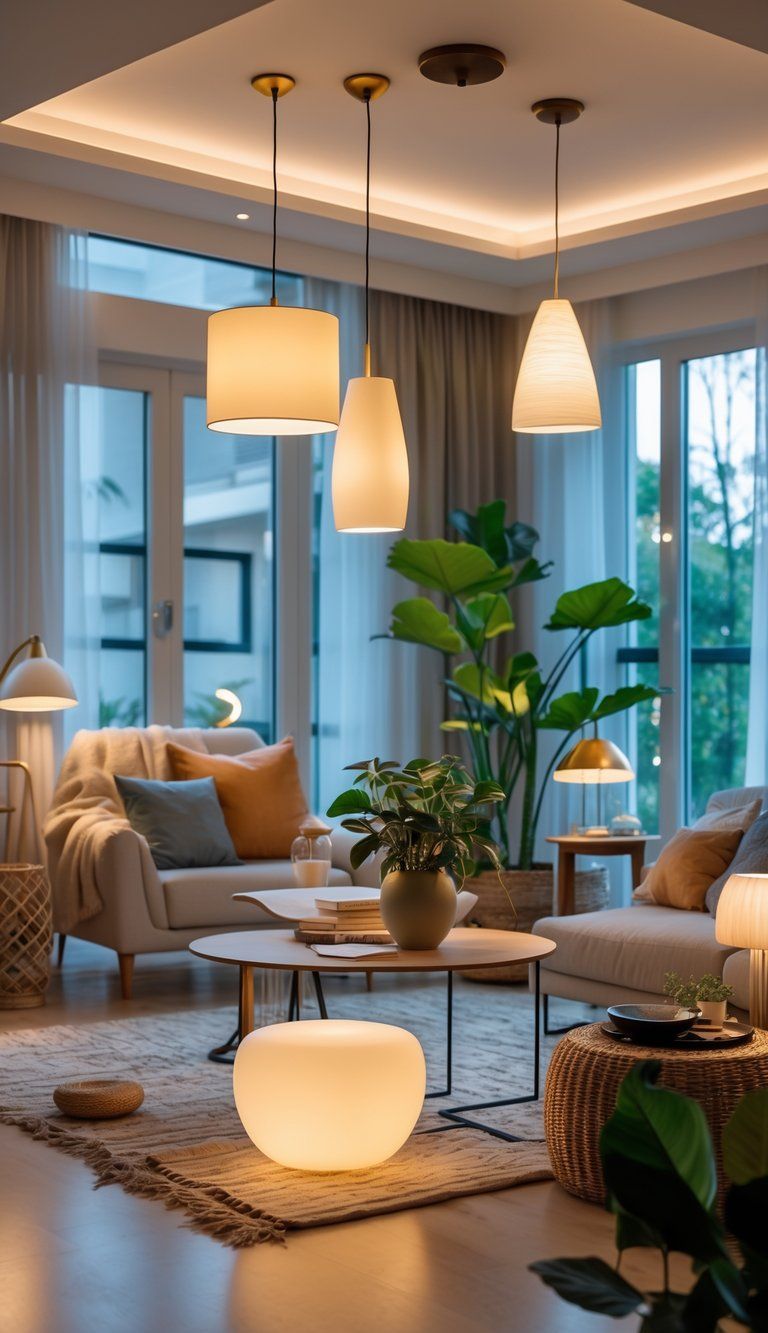
Lighting is honestly one of the best ways to set the mood and show off your style. The right choices can turn a basic space into something special, all without losing function.
Maximizing Natural Light
Natural light just makes everything feel more welcoming. Place mirrors across from windows to bounce sunlight around. Pick window treatments you can pull back all the way, but still close for privacy.
Move things that block the light. Trim outdoor plants or shift furniture that’s in the way.
Install glass doors or interior windows if you can—they let light flow between rooms. If you’re up for a bigger project, skylights or solar tubes bring natural light into dark spots.
Wall colors matter, too. Lighter, neutral shades reflect more sunlight, while dark ones soak it up. For rooms that don’t get much sun, try warm whites or light yellows to fake a sunnier vibe.
Layering Accent Lighting
Good lighting needs layers. Start with ambient lighting for the whole room, add task lighting for specific jobs, and use accent lighting to highlight what you love.
Wall sconces add soft light and texture—great for hallways, bathrooms, or beside the bed.
Some fun accent lighting ideas:
- Picture lights for artwork
- Under-cabinet lighting in the kitchen or bathroom
- Bookshelf lighting for collections
- LED strips behind the TV or under furniture
Dimmer switches let you control how bright things are, depending on the time or your mood. That way, you can go from bright and practical to soft and cozy in seconds.
Smart lighting lets you set up different “scenes” for movie night, parties, or just relaxing.
Choosing Energy-Efficient Lighting
Choosing energy-efficient lighting cuts bills and helps the planet. LED bulbs use way less energy than old-school bulbs and last much longer.
Pick the right color temperature for each space:
- 2700-3000K (warm white) for living rooms and bedrooms
- 3500-4100K (cool white) for kitchens and workspaces
- 5000-6500K (daylight) for reading or crafts
Smart bulbs can be scheduled, controlled from your phone, and even change color. Some adjust automatically based on the time of day, which is pretty cool.
Go for decorative fixtures that look good and save energy. Edison-style LED bulbs give vintage charm without the waste.
Motion sensors in hallways or closets keep lights from being left on, which saves energy and adds convenience.
Maximizing Storage Solutions for Style and Function
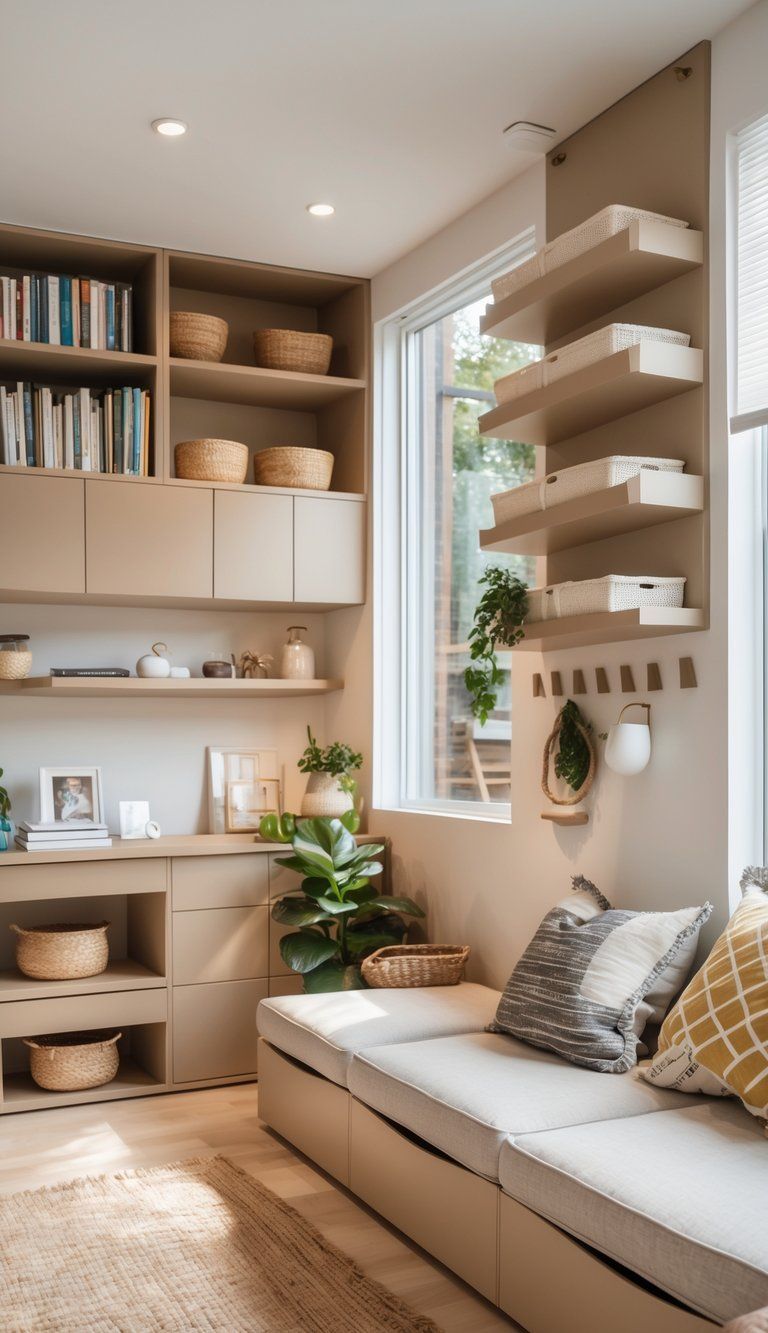
Smart storage can totally change your home. It’s all about balancing hidden storage for clutter and open spots for your favorite things.
Integrating Hidden Storage
Hidden storage keeps things tidy but close by. Try cabinets with push-to-open doors that blend right into the wall—no handles, just clean lines.
Don’t overlook the space under stairs. Custom drawers or pull-outs are perfect for seasonal or seldom-used stuff.
Hollow ottomans and coffee tables with lift-up tops hold blankets, magazines, or remotes out of sight, but right where you need them.
Add tension rods inside cabinets to hang cleaning supplies or small items. It’s a low-effort way to double your storage.
Using Custom Furniture
Custom furniture can solve your storage problems and fit your style. Built-in bookcases around windows or doors add interest and give you more room for books or decor.
Beds with drawers underneath mean you don’t need extra dressers in small spaces. That keeps your floors open and tidy.
A custom entertainment center can hide cords and devices while showing off your favorite pieces.
Dining benches with hidden storage are great for stashing table linens or art supplies.
Organizing With Aesthetic Appeal
Pretty storage containers make organizing look intentional. Woven baskets add texture and hide toys or electronics.
Glass jars in the kitchen keep dry goods visible and neat. Add simple tags for a practical, pulled-together look.
Decorative boxes on shelves hold all the little things that usually clutter up your space. Pick colors that match your palette.
Wall-mounted storage can be both useful and stylish. Floating shelves show off treasures and keep things handy.
Try color-coding your storage bins for a bit of harmony. It makes everything look planned and pleasant.
Incorporating Plants and Nature-Inspired Elements
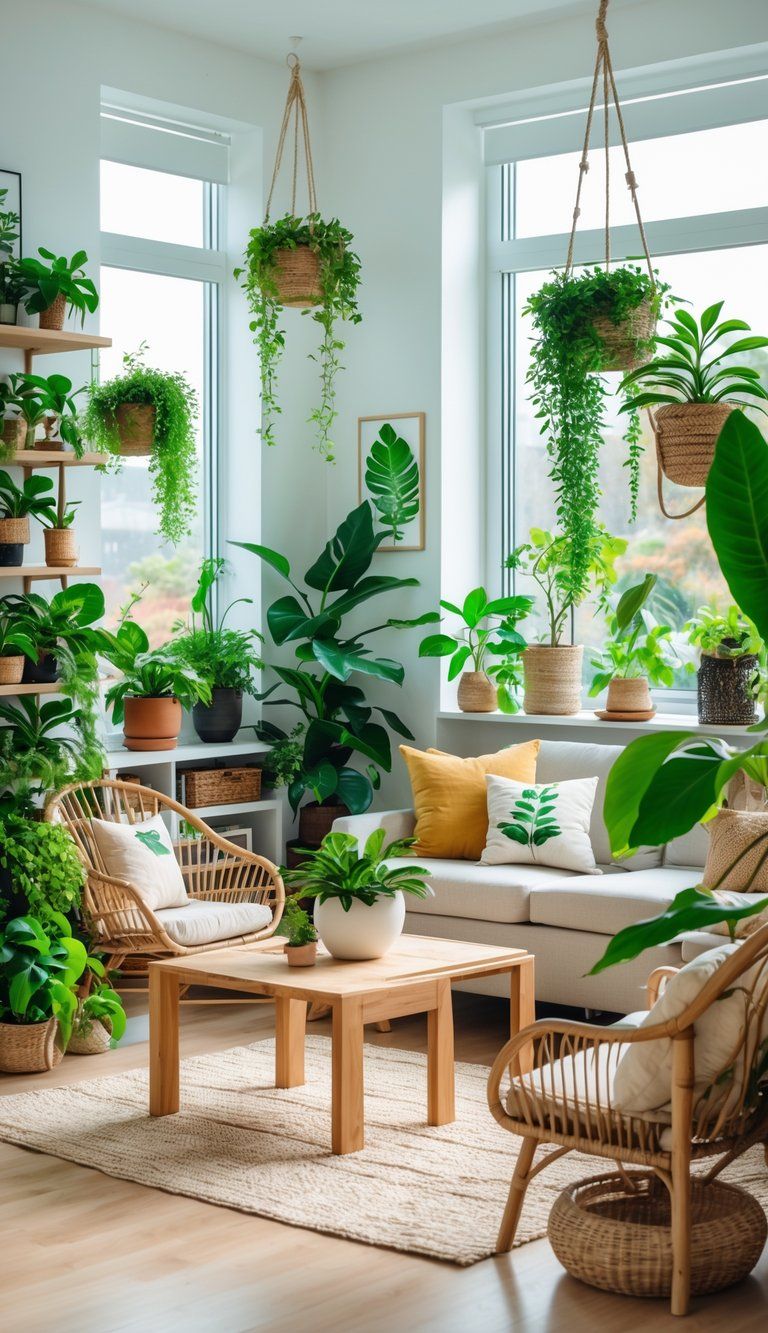
Bringing nature indoors gives your home a fresh, relaxing vibe. Plants and natural elements add warmth, texture, and life—without sacrificing practicality.
Choosing the Right Plants
Look at your light first. South-facing windows are best for sun-lovers like succulents or fiddle leaf figs. North-facing windows suit shade-friendly picks like peace lilies or snake plants.
Be honest about how much care you can give. If you travel, go for low-maintenance plants like ZZ plants or pothos—they’re tough and forgiving. In busy rooms, skip anything with delicate leaves that might get damaged.
Match the plant size to your space. Tiny apartments work well with air plants or herbs. If you have more room, try something bold like a monstera or bird of paradise.
Don’t forget about air-purifying plants like spider plants or rubber plants. They clean the air and look good doing it.
Arranging Greenery for Visual Impact
You can create visual interest by mixing up plant heights and textures. Try putting tall plants like palm trees in corners, medium ones on shelves, and let trailing ivy spill down from high spots.
Group your plants in odd numbers—three or five look more natural than pairs. It’s a simple trick, but it really makes the arrangement feel less staged.
Think about where plants might work best:
- Fill empty corners that feel a bit lifeless
- Use coffee tables as a spot for a living centerpiece
- Place herbs on kitchen counters for both looks and function
- Set tropical plants on bathroom shelves where the humidity helps them thrive
Pick containers that match your style. Ceramic pots fit modern homes, woven baskets give off a boho vibe, and concrete planters feel more industrial.
Blending Plants With Existing Décor
Try to match your plant pots to your room’s color scheme for a pulled-together feel. Terracotta works with warm colors, while sleek white or black containers look great in minimalist spaces.
Don’t stop at plants—bring in other natural elements too:
- Add wooden furniture with visible grain
- Use stone countertops or small accessories
- Roll out a jute or sisal rug
- Toss in cotton or linen textiles in earth tones
Let plants help solve design problems. Tall ones can hide awkward corners, and hanging varieties pull the eye up in rooms with low ceilings.
Move your plants around with the seasons. Swap out table arrangements or shift big plants to different corners when you want a change, no shopping required.
Choosing Functional Decor Elements
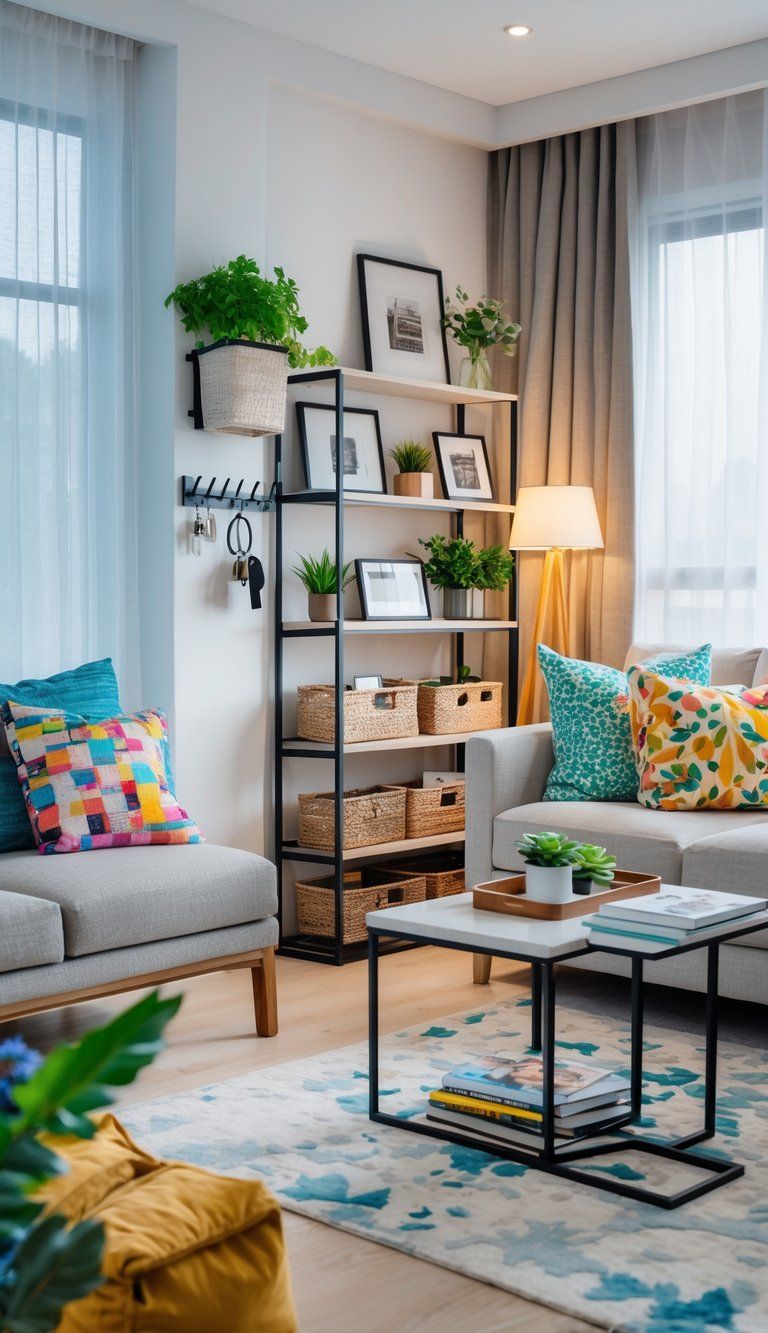
When you decorate your home, you want things that look good but also do something useful. Functional decor saves space and adds style without making your place feel cluttered.
Integrating Modern and Minimalist Decor
Minimalist decor is all about keeping things simple. Pick multi-purpose furniture—like storage ottomans or beds with drawers underneath. These pieces pull double duty without eating up extra space.
Wall-mounted shelves show off your favorite items and get rid of bulky bookcases. Floating desks that fold away are great if you need to reclaim space.
Choose furniture with clean lines and simple shapes. A coffee table with hidden storage keeps remotes and magazines out of sight but close at hand.
Use neutral colors as your base. White, beige, and gray make rooms feel calm and open. Add a few pops of color with small accessories that you can swap out whenever you want.
Selecting Energy-Efficient Appliances
Energy-efficient appliances help you save money and lower your environmental impact. Look for the ENERGY STAR label when you shop for kitchen appliances, washers, or heating systems.
Smart thermostats learn your routine and adjust the temperature for you. Some even let you control them from your phone, so you can turn things off when you’re not home.
LED bulbs use up to 75% less energy than old-school bulbs and last way longer. Try dimmer switches to set the mood or just save a bit more energy.
Choose appliances that fit your style. These days, you can find energy-efficient models in matte black, stainless steel, or even custom finishes.
Maintenance Tips for Functional Style
Set up a seasonal schedule to keep your functional decor working right. Clean air vents and swap out filters in purifiers and HVAC systems every few months for better air quality.
Dust your light fixtures often to keep them bright. Always turn off the power before cleaning pendant lights or chandeliers—safety first.
Treat wooden furniture with the right polish or conditioner. Each wood type needs its own care, so check what works best for yours.
Keep multifunctional furniture in shape by lubricating hinges and checking moving parts. This keeps things like pull-out beds and folding tables working smoothly.
Rotate your decorative items with the seasons. Just moving things around can make your space feel new, and it won’t cost you anything.
Personalizing With Patterns and Window Treatments
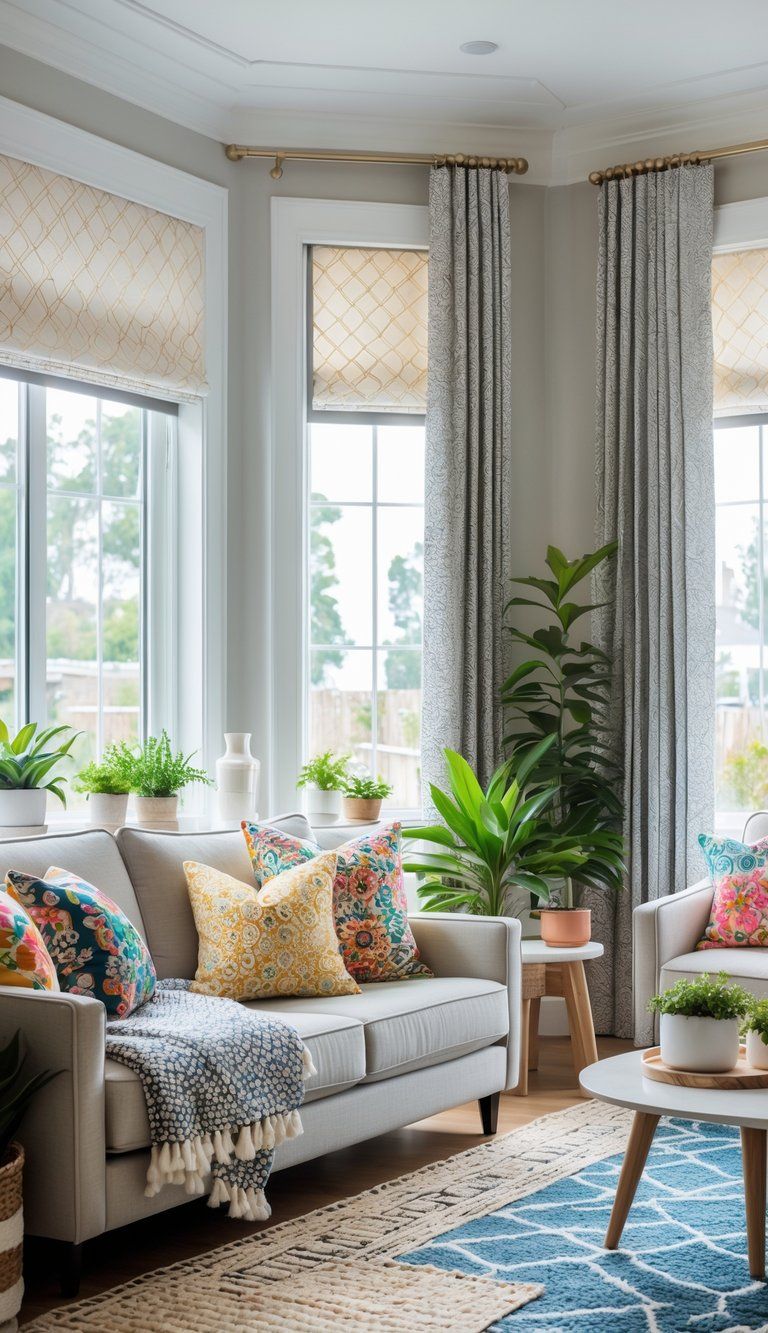
Patterns and window treatments let you show off your personality and keep your home practical. These details can totally change a room without a ton of effort.
Selecting Patterns for Personality
Patterns tell your story, so trust your gut when you pick them. If you’re nervous, start small—throw a patterned pillow on the sofa or drape a bold throw over a chair.
Mix up the scale for balance. Pair big, wide stripes with tiny florals or geometric prints. It keeps things interesting without going overboard.
Think about the room’s vibe. Bold, energetic patterns suit living rooms, while softer ones help bedrooms feel calm.
Layer patterns in different ways:
- Textiles: Rugs, curtains, pillows
- Wallpaper: Try an accent wall or go all in
- Furniture: Upholstered chairs or small decorative pieces
Choosing the Best Window Treatments
Window treatments aren’t just about looks—they control light, give privacy, and frame your view.
Pick what fits the room. Blackout curtains are perfect for bedrooms, while sheer fabrics let in light for living spaces. Layer blinds under curtains for more options throughout the day.
Think about your windows’ size and shape. Floor-to-ceiling drapes make ceilings feel higher, and horizontal blinds suit wide windows. Roman shades are great for kitchens and bathrooms where you don’t want fabric touching counters.
Color and texture matter a lot. Bold window treatments can be the focal point, while neutral ones just blend in. Textured fabrics—maybe linen for a relaxed look or velvet for something fancier—add depth to any room.
Conclusion: Creating a Personalized Sanctuary
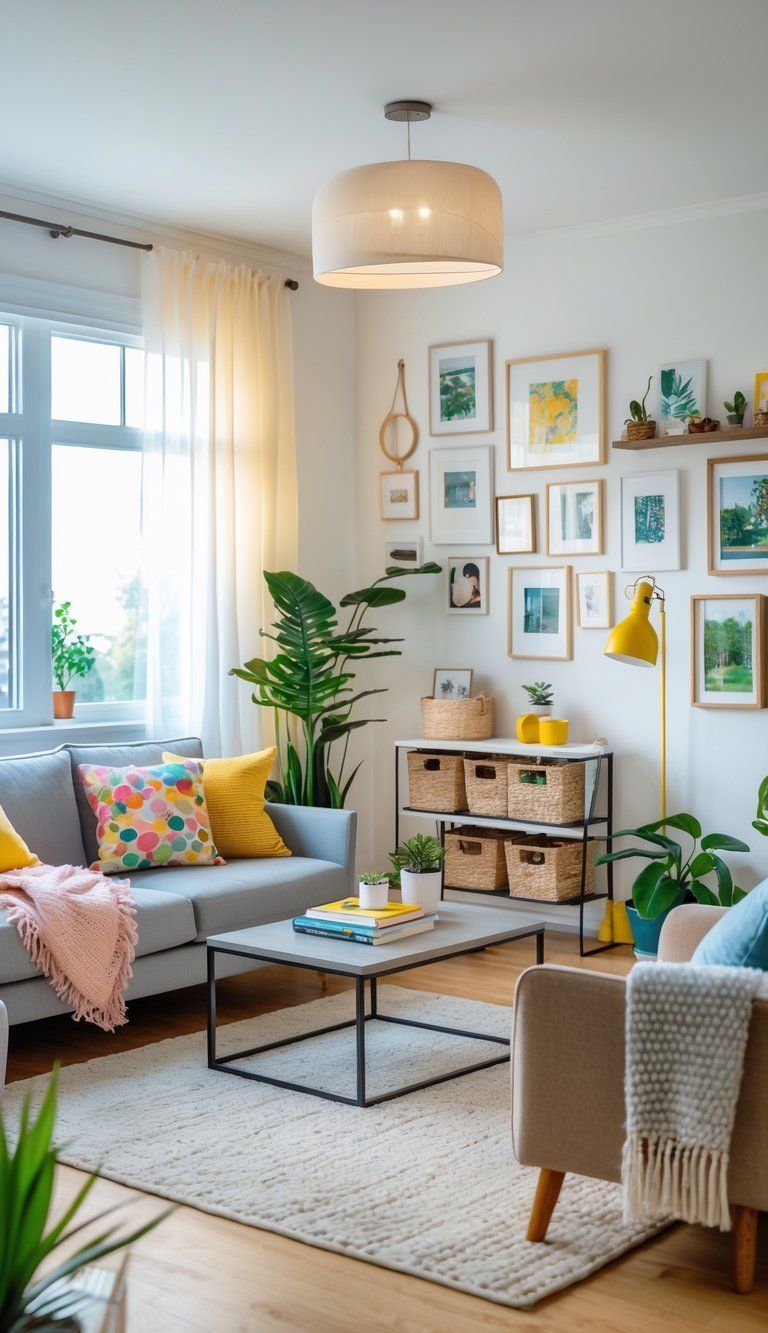
Your home should really show who you are and fit your daily life.
When you blend personal style with function, you don’t just make a living space—you end up with a true sanctuary.
You don’t have to give up practicality to make your space feel like you.
Sometimes, just swapping in custom throw pillows or hanging up art that means something to you can make a plain room feel uniquely yours.
Finding the right balance matters.
Pick details that match your taste, but make sure they actually work for your day-to-day life.
Maybe you go for pretty storage baskets, or you grab a coffee table that hides clutter.
Take your time with it.
Building your own sanctuary doesn’t happen overnight, and honestly, it shouldn’t.
Let your space change as you do—it’s more fun that way.
A few tips that might help:
- Start small: Tackle one corner or shelf, then move on
- Be intentional: Buy what you love, not what’s trending
- Edit regularly: Clear out what doesn’t fit or bring you happiness
- Embrace change: Your style and needs aren’t set in stone
Your home really ought to give you comfort and inspiration.
When you mix your style with practical choices, you’ll end up with a space that not only looks great but actually feels right.
Go with your gut—after all, you’re the one who has to live there.

